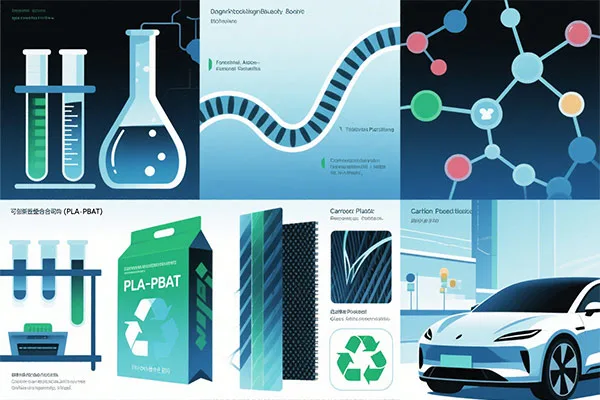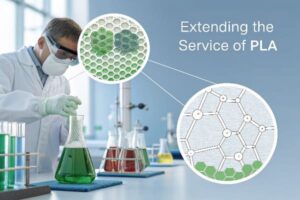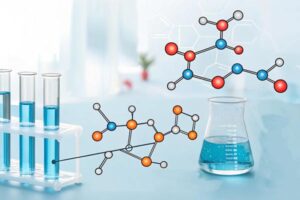Chemicals are at the forefront of today’s technological revolution. The use of advanced chemical products is driving innovation across every major industry—from automotive and electronics to packaging and renewable energy. With increasing demands for sustainability, performance, and recyclability, these materials are transforming modern manufacturing and engineering.
This article highlights the top 10 most innovative chemical products that are not only solving current challenges but also preparing industries for a more efficient, sustainable future. Special focus is given to functional additives—such as chain extenders, anti-hydrolysis agents, and reinforced composites like carbon fiber and glass fiber compounds—which are essential to high-performance, sustainable design.
1. Biodegradable Polymers (PLA and PBAT Blends)
Biodegradable plastics, such as Polylactic Acid (PLA) and Polybutylene Adipate Terephthalate (PBAT), are emerging as eco-friendly alternatives to petroleum-based plastics. These materials decompose under industrial composting conditions, making them ideal for sustainable packaging applications.
However, their low mechanical strength and poor hydrolytic stability limit their broader industrial use. PLA can become brittle over time, while PBAT lacks sufficient rigidity.
Solution: Chemical modification using chain extenders and anti-hydrolysis agents significantly increases molecular weight and water resistance, expanding their application in agriculture films and takeaway containers.
Industries: Packaging, agriculture, food service
Applications: Compostable bags, disposable utensils, mulch films
2. Functional Plastic Additives – Chain Extenders and Anti-Hydrolysis Agents
Functional plastic additives are essential for polymer processing and long-term performance. Among them, chain extenders and anti-hydrolysis agents are the most impactful.
Chain Extenders
These additives react with terminal carboxyl or hydroxyl groups, effectively lengthening or rebuilding polymer chains. The result is improved viscosity, tensile strength, and thermal resistance.
Common types:
- Epoxy-functional chain extenders: HyMax KL-180
- Oxazoline-based (ideal for PLA or polyamide)
- Anhydride-functional agents (for PET, PC)
Anti-Hydrolysis Agents
Hydrolysis is a key degradation pathway for polyesters and polyurethanes. Carbodiimide-based anti-hydrolysis agents neutralize acidic end groups, significantly extending polymer life under hot and humid conditions.
See more about: what is an anti-hydrolysis agent?
Industries: Automotive, textiles, electronics, recycling
Applications: Fiber spinning, 3D printing, food packaging, hot-fill containers
3. Carbon Fiber and Glass Fiber Reinforced Materials
Fiber-reinforced thermoplastics are critical for applications demanding a high strength-to-weight ratio.
Glass Fiber Reinforced Plastics (GFRP) are widely used in automotive and consumer goods due to their rigidity and cost-efficiency. Carbon Fiber Reinforced Plastics (CFRP) offer even higher strength, stiffness, and fatigue resistance—perfect for aerospace and high-performance vehicles.
Reinforced polymer examples:
GF/CF PP – Lightweight car bumpers, battery casings
GF PA6/PA66 – Automotive components, cable insulations
CF PEEK/PEI – Aircraft interior parts, medical tools
Industries: Transportation, electronics, industrial equipment
Applications: Lightweight panels, gear housings, structural brackets
4. Crosslinking Agents
Crosslinkers form irreversible bonds between polymer chains, creating a 3D structure that enhances dimensional stability, chemical resistance, and thermal durability.
Types of crosslinkers:
- Isocyanates
- Silanes (for moisture-cure systems)
- Organic peroxides
- polycarbodiimide
Industries: Construction, electronics, aerospace
Applications: Powder coatings, thermoset adhesives, rubber vulcanization
Crosslinking is critical for durability in demanding environments.
5. Self-Healing Polymers
Self-healing polymers can repair themselves using reversible chemical bonds or microencapsulated healing agents, much like biological tissue.
Trigger mechanisms:
- Heat-activated reversible covalent bonds
- Light-induced crosslink regeneration
- Pressure-sensitive microcapsules
Benefits: Reduced maintenance costs, extended product life, minimized downtime
Industries: Aerospace, defense, wearable electronics
Applications: Scratch-resistant coatings, structural parts, flexible devices
6. Graphene Nanocomposites
Graphene, an atomically thin carbon sheet, is being added to thermoplastics and coatings to dramatically enhance performance.
Key benefits:
- Outstanding electrical and thermal conductivity
- Improved mechanical stiffness
- Excellent UV and gas barrier properties
Industries: Semiconductors, energy storage, advanced composites
Applications: Printed circuits, EMI shielding, flexible screens
7. Smart Hydrogels
Stimuli-responsive hydrogels are revolutionizing sectors like medicine, agriculture, and personal care by reacting to environmental changes such as pH, temperature, or ionic strength.
Examples:
- Temperature-sensitive gels for drug release
- pH-responsive gels for targeted therapy
- Water-retaining gels for drought-prone agriculture
Industries: Life sciences, agriculture, personal care
Applications: Contact lenses, wound dressings, smart irrigation
8. UV-Curable Resins
UV-curable resins provide instant curing, low VOC emissions, and excellent adhesion, ideal for eco-friendly, high-speed production.
Key components:
- Acrylate monomers and oligomers
- Photoinitiators
- Crosslinking agents
Industries: 3D printing, electronics, coatings
Applications: Smartphone coatings, PCB encapsulation, optical lenses
9. High-Barrier Coating Materials
Barrier coatings protect against oxygen, moisture, and UV radiation, especially in FMCG and pharmaceutical packaging.
Technologies:
- Nanoclay dispersions for oxygen resistance
- AlOx/SiOx coatings for transparency and UV shielding
Industries: Packaging, pharmaceuticals, logistics
Applications: Snack wrappers, blister packs, OLED films
10. Recycled PET Additives (rPET)
For recycled PET (rPET) to rival virgin PET in performance, additive-based upgrading is essential, particularly when chemical recycling is not feasible.
Enhancement strategies:
- Chain extenders to rebuild molecular mass
- Compatibilizers to improve phase dispersion
- Stabilizers to extend shelf life
Industries: Fashion, food & beverage, household goods
Applications: rPET fibers, thermoformed trays, clear beverage bottles
Conclusion: Innovation Starts with Chemistry
The future of industrial innovation is being shaped by smart, high-performance, and sustainable materials. Whether it’s chain-extended PLA, glass fiber-reinforced PA, or rPET enhanced with stabilizers, these breakthroughs depend on advanced chemical science.
For manufacturers, designers, and engineers, mastering these innovations is no longer optional—it’s a strategic imperative in today’s performance-driven, environmentally-conscious global economy.







